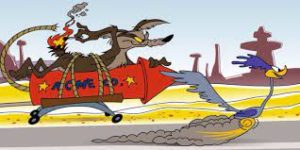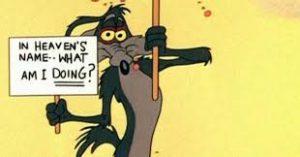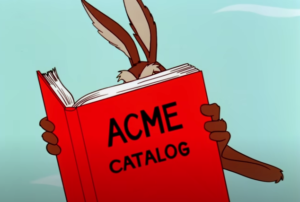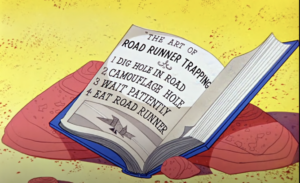Leadership Lessons from Wile E.
Leaders make a lot of decisions. After reading Thinking, Fast and Slow by the economist, psychologist and professor, Dr. David Kahneman, not only are a lot of decisions made on a daily basis but my decision making process involves the interplay of two systems. System one is the automatic system that acts without conscious effort, while system two requires a lot of mental effort. [1] Some research suggests I make as many as 35,000 decisions every day. Researchers at Cornell University estimate individuals make 226.7 decisions each day on food alone. As your level of responsibility increases, so do the numerous choices one has to make. It’s estimated that an adult makes about 35,000 remotely conscious decisions each day. [2] Each decision I make carries certain consequences that are both good and bad. Has anyone ever had a problem arise when system one went to action, instead of system two? Or system two, when left in charge, led to a decision made out of inexperience, leading to disaster? [3] All of us are all too familiar with this leadership dynamic, even Wile E. Coyote.
Leadership Lessons from Wile E.
*Disclaimer – Often the craft of teaching, especially elementary students, involves taking big concepts and breaking them down into more bite size chunks that students can master. Have a little fun with me here, Wile E. fans? (or not).
As I was thinking about the concepts presented in Kahneman’s book, and the need to relate to them in a fun way (it has been a crazy week), Wile Ethelbert Coyote, the creative coyote who never succeeded in catching his opponent, Road Runner, came to mind. This inventive, Saturday morning cartoon character lacked differentiation (impatient, often displaying emotion on a sign for viewers to read) and in many instances did not plan for potential consequences of his actions (often falling off of a cliff). [4] This persistent coyote went to extreme lengths to succeed, even if it meant hurting himself in the process. [5] While Wile E. Coyote may not have been the most differentiated leader, he often had to think fast, making unconscious decisions based on memories of past actions (that failed) and emotions (linked to that failure) to do all that he could to try to catch the Road Runner. In leadership, these gut decisions are about as right as many times as they are wrong, Kahneman states, therefore we can’t rely on them with any confidence. [6] However, Wile E.’s qualification is “Genius” (check out his business card).
Wile E. was often found consulting, or anchoring his decisions using the ACME catalog, A Company that Makes Everything catalog. Maybe similar to Amazon? He often anchored his success on the contents of the catalog hoping for the realization of his dream, a meetup with the speedy Road Runner.
During decision making, anchoring occurs when individuals use an initial piece of information to make subsequent judgments. Once an anchor is set, other judgments are made by adjusting away from that anchor, and there is a bias toward interpreting other information around the anchor. [7] There have been times in my leadership when I have created an anchor, and then realized that a bias was created, framing my understanding of that situation, either positively or negatively. This happens quite frequently in education, when a practice is adopted based on an interpretation of data to later discover that a bias has formed for that particular method, but needs to be adjusted or shifted to allow for new learning. This may have also been the case for Wile E., noting that in many episodes he favored the use of explosives and extreme measures to catch and eliminate Road Runner, often ending in a fall off a cliff. Ouch!
 .
. 
After trying several ACME products, Wile E. Coyote quickly jumps to conclusions, not having all of the facts. Referencing the book, Thinking, Fast and Slow, the author uses the acronym, W.Y.S.I.A.T.I. or “what you see is all there is” as a way to illustrate how leaders often jump to conclusions with limited information. I have found that it is helpful for me to ask questions and gain understanding as a way to understand the fact that there is more to the story. Chuck Jones, who directed most of the Wile E. Coyote shorts stated that he based Wile E. partly on himself, since he frequently failed or injured himself attempting to use tools or do repairs at home. [8] Jones’ portrayal of his own struggles through Wile E. also reminds us that within all forms of art, what you see is not all there is.
I appreciate Chuck Jones’ animation of a character, who like all of us, experiences the challenges of making decisions with a balance of both systems one and two. There have been a few times this week when I felt the effects of a busy and depleted system two, feeling tired and not wanting to make another decision. Amen? While I may feel depleted when my systems are not firing as they should, I am incredibly grateful that God gives wisdom so that I can make good decisions even in my depletion . . .
“If you need wisdom, ask our generous God, and he will give it to you. He will not rebuke you for asking.” James 1:5 [9]

Feelings of depletion pass and while I may find myself wanting to hold up a sign with my emotions, “In Heaven’s Name. . . What am I doing?”, I center my mind on “whatever is true, whatever is noble, whatever is right, whatever is pure, whatever is lovely, whatever is admirable—if anything is excellent or praiseworthy—think about such things.” Philippians 4:8 [10]
[1] Daniel Kahneman, Thinking, Fast and Slow (New York: Farrar, Straus and Giroux, 2013).
[2] “How Many Decisions Do We Make Each Day?” Psychology Today, accessed February 27, 2023, https://www.psychologytoday.com/us/blog/stretching-theory/201809/how-many-decisions-do-we-make-each-day.
[3] Daniel Kahneman, Thinking, Fast and Slow (New York: Farrar, Straus and Giroux, 2013).
[4] Warner Brothers, “Looney Tuesdays”, accessed February 26, 2023, https://www.youtube.com/watch?v=Aewj-0wcMIo.
[5] Edwin H. Friedman and Peter Steinke, A Failure of Nerve: Leadership in the Age of the Quick Fix (10th Anniversary, Revised Edition) (New York: Church Publishing Incorporated, 2017).
[6] Daniel Kahneman, Thinking, Fast and Slow (New York: Farrar, Straus and Giroux, 2013).
[7] “The Anchoring Effect and How it Can Impact Your Negotiation,” Harvard Law School, accessed February 27, 2023,
[8] Welcome to the Chuck Jones Virtual Experience, accessed February 26, 2023, https://chuckjones.com/characters/wile-e-coyote/.
[9] New Living Translation, James 1:5.
[10] New International Version, Philippians 4:8.
4 responses to “Leadership Lessons from Wile E.”
Leave a Reply
You must be logged in to post a comment.



Hah – I saw the headline and I wondered “Is Cathy going to write about the Roadrunner and Wile E. Coyote?” I am so glad you did. What a wonderful analogy that spoke well to my brain.
Having read your post, I began asking myself what tools do I go to again and and again and what am I missing out on by not exploring other ideas. I worked with a company that did a postcard campaign to a neighbourhood once a year advertising 50% off their products and typically they would see a 10% bump in sales. When I began working with them I introduced them to the idea of A/B testing: let’s create two postcards that offer the same deal but said differently.
They had always thought they were doing well with a 10% boost in sales. However, we distributed two postcards that year, one which offered 50% and one that read 1/2 price sale. The 1/2 price sale postcard resulted in a 20% increase in sales!
What is remarkable to me about your post is not only did you so eloquently use a fun analogy (you should be the hot seat this week, fyi, just my opinion) but you also showed me that even though I can help a company recognize they are a victim of framing, I myself have been paralyzed to look at new ways of doing things.
Thanks for the great post!
I am so glad you got my analogy. . . It may have been a stretch but it is good to look at life (or ourselves) not too seriously.
Hi Cathy,
Thank you for such a creative and fun post. I almost missed it! Thanks for highlighting anchoring. You mentioned anchoring could lead to framing a situation either positively or negatively. Can you unpack how framing something positively could lead to an unhelpful bias?
Jenny,
Thank you for asking. There have been times in my life when I have anchored my thinking on something read or experienced, maybe more like a theory, and then realized that a bias was created out of my theory, framing my understanding of situation that appear similar, either positively or negatively.